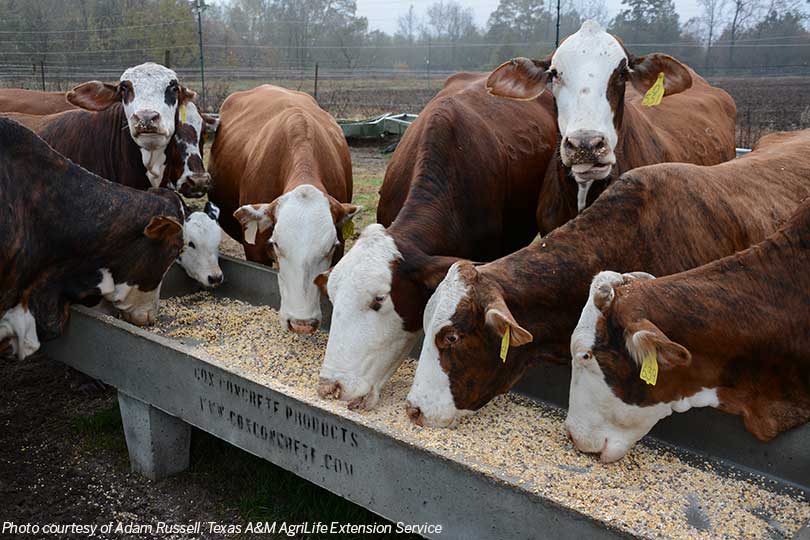Cattle supplement feeding: tips for Hopkins County ranchers by Dr. Mario A. Villarino, County Extension Agent for Agriculture and Natural Resources

[adning id=”33097″]

Supplements must be chosen to meet particular nutrient deficiencies. Body condition is a key factor in the choice of supplements. According to Texas A&M AgriLife Extension, thin cows are relatively more deficient in dietary energy than in protein. In contrast, fleshier cows may need extra protein, if they need anything.
[adning id=”33207″]
To minimize supplementation, use forage supplies logically. In general, hay (excluding supplemental alfalfa, etc.) should not be limit-fed with standing forage. Limit-feeding of hay encourages cows to reduce grazing and fails to use pastures while quality is reasonably good. For example, assume available forage for grazing or feed ing includes some tame pasture (such as coastal-bermudagrass), some native range, and some hay. As winter approaches, the tame pasture should be used first, native range next, and hay last. That way each forage is utilized most efficiently, and there is a better chance some hay will be left in late winter to early spring when high quality green growth begins but is limited in amount. It is difficult to make general recommendations about supplementation of protein and energy. Usually, dry mature cows in medium or higher body condition on typical dormant warm-season pasture or low quality hay often need only 1 pound to 2 pound s a day of a high protein feed. (On extremely low quality forage, such as tall-grass prairie in winter, 3 pound s to 4 pound s of high protein feed may be needed.) A thin, dry, mature cow may require 2 pound s to 4 pound s daily, but of a medium -protein, high-energy supplement. After calving, all of these amounts essentially should be doubled. Daily feeding usually is not necessary when using high-protein supplements such as cottonseed meal cubes. Instead, depending on the amounts, weekly required totals can be divided and fed every other day, twice a week, or even once a week. In fact, nondaily feeding of these supplements often is more efficient. However, combination protein-energy supplements, especially breeder /range cubes and meal-grain mixes, that are required in larger daily amounts, generally should be fed daily for best forage utilization, highest animal performance, and greatest efficiency.Self-fed, controlled consumption can be accomplished with some feeds, especially oilseed meals and meal-grain mixes, by including an intake limiter such as salt. Cattle then will consume salt in maximum amounts of approximately 0.1 percent of body weight, or about 1 pound of salt consumption daily by a 1,000 -pound cow. So, to obtain supplement consumption of 3 pound s daily in a 1,000 – pound cow, a mix of 1 pound salt to 3 pound s supplement should be provided. When using salt to limit consumption, plenty of high quality water must be available. Also, cows consume more of a salt-limited supplement when it is located close to a water supply. Perhaps the most common supplement is a high quality 20 percent CP breeder /range cube (high or all-natural protein and low crude fiber ), or the equivalent. Such a supplement often is a compromise for the common situation of low quality forage and low to medium body condition. But this must be fed in adequate amounts, typically 3 to 6 pound a day, to be effective. In fact, with the exception of managing weight loss in fleshy cows, there are few situations where feeding smaller amounts of such cubes is applicable. If a producer is unwilling or unable to assume the cost of required amounts of these cubes (or the equivalent), then a lower amount of a higher protein feed should be fed. But realize, however, that body condition, reproduction, productivity, and profit are likely to decline if nutrient requirements are not met.
For more information on this or any other agricultural topic please contact the Hopkins County Extension Office at 903-885-3443 or email me at m-villarino@tamu.edu.
[adning id=”33207″]











